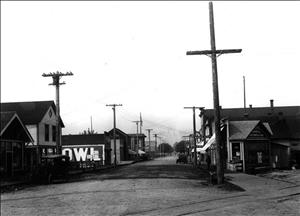The opening of a post office is an important marker of the beginning of a community. On May 20, 1870, the Squak Post Office is established. William Pickering is the first postmaster. The name Squak is an attempt to pronounce an Indian name sometimes written "Is-qu-ah" and sometimes said to mean "snake." The town, located in eastern King County 15 miles east-southeast of Seattle, will later be called Englewood, Olney, and Gilman before inhabitants settle on another variant of "Is-qu-ah" -- Issaquah -- in 1895 and the legislature makes it official in 1899.
Squak
L. B. Andrews discovered coal along the Squak River in the fall of 1862. However, mines were not developed until later when the railroad was built to transport the coal. The name Squak was the how some settlers pronounced an Indian name for the area, "Is-qu-ah," which some accounts record as meaning "snake" (other accounts say it meant "little stream" or referred to the call of the northern crane which was common in the area). Squak began as a farming community from which produce began to be shipped in 1867 or 1868. George W. Tibbetts ran a hotel, C. M. Brank served as the blacksmith, and brothers Ingebright and Lars Wold were shoemakers. The Wolds also planted a half acre of hops. There were also two teachers.
Mail was delivered to Squak by Clarence Bagley who brought it by horseback from Seattle along a route that went around the south end of Lake Washington. (Bagley was the future historian of Seattle and King County.) His mail delivery route took him three days round trip. Bagley later wrote of the settlement, "When the soil had been placed under cultivation, potatoes were raised for human food, and turnips and rutabagas for feed" (Bagley, 765).
Olney -- or Gilman
In 1887, Daniel Hunt Gilman established the Seattle Coal and Iron Co. in Squak. The area was then platted as Englewood by Ingebright Wold (1888), who disliked the name Squak and called the plat by a variation of his own name. The Gilman mines opened, and the Seattle, Lakeshore & Eastern Railway reached the mines and called its station Gilman. The U.S. Post Office Department declined to accept the name Gilman because of its similarity to Gilmer, a town in Klickitat County, and on January 31, 1889, the post office was changed to Olney. However the town was incorporated in 1892 as Gilman. Gilman essentially became a coal town.
The postmaster at the time of the name change was George Parks and the "Olney" post office was located in the office of the Gilman mines. Gilman had a blacksmith shop, a hotel, two saloons, a meat market, two sawmills, and a general store. In 1885, the population, according to Bagley, was 100. In 1890, 200 ballots were cast for King County sheriff.
Finally, Issaquah
On June 10, 1895, the town renamed itself a final time, as Issaquah. Henry Hunter was then postmaster, and he distributed mail from his drug store.
The new name, another variant of "Is-qu-ah," had been growing in favor for some time. On February 2, 1899, the Washington State Legislature officially changed the name to Issaquah. The population of Issaquah in 1900 was 1,060.

